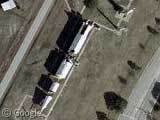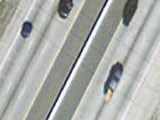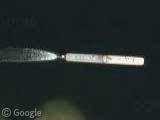US Space & Rocket Center
Thursday, 12th February 2009 by James Turnbull
NASA's first visitor centre, and one of the world's largest public collections of space bits is the U.S. Space and Rocket Center near Huntsville, AL.
The main building houses hundreds of space-related artefacts, including bits of real moon rock and the remains of a space monkey, but luckily the best sights are too large to squeeze inside the building and have to be displayed outside1.
Welcoming you to the centre is an A-12 Blackbird which, as I'm sure you know, isn't a spacecraft, it's a plane. But, it's a very cool plane, so we'll let them off2.
Also noticeable from the entrance is the massive Saturn V, the rocket design that launched NASA's Apollo and Skylab missions.
However, like the Blackbird, this isn't a spacecraft; it's just a full-size mock-up produced especially for the park.
Hoping to actually see some real space things, we come to another Saturn V, this time lying down.
Now this is (sort of) the real deal. Although all three stages come from separate test models not destined for flight, it does have all the inner workings and has thus been awarded the prestigious status of a US national monument.
Alongside Saturn V stands a smaller rocket, Saturn I, which was NASA's first dedicated "space launcher".
Again, this particular rocket was never launched, and like the Saturn V is actually a mish-mash of test models. Someone who clearly knows too much about space rockets complains that the booster is even painted incorrectly: "the roll pattern on the fins is also off, as the black-white boundary should be horizontal to the ground an[d] bisecting the root edge of the fins." Of course we all noticed that glaring error.
Around the other side of the building we find the only "full stack" space shuttle display in the US.
The empty steel model, known as "Pathfinder", was constructed as an simple weight for testing cranes and other support equipment. It was given the NASA livery in Japan, where it spent some time at the "Great Space Shuttle Exposition" of 1984.
It then returned to America to where we see it now, sitting atop two prototype booster casings which never went into production.
So that was the U.S. Space and Rocket Center, where we can see precisely zero rockets that have ever actually been into space!
-
Actually, the Saturn V we see here has since been moved indoors, so they must have had a lot of free space in there. ↩︎
-
NASA did fly the related YF-12s in the 1970s, and this A-12 has its tailfin painted in a similar style - presumably they thought no-one would notice the difference? ↩︎











where we can see precisely zero rockets that have ever actually been into space
Well, to be fair, I think this is true for any other place on this planet as well, at least if we limit it to whole rockets and not just their payloads.
I was in Huntsville last July and visited the Space & Rocket Center. They built an entire building for the express purpose of housing the Saturn V rocket mentioned here. Live Search Maps shows construction in the early stages:
http://maps.live.com/default.aspx?v=2&FORM=LMLTCP&cp=psjmhd7sbtmq&style=b&lvl=1&tilt=-90&dir=0&alt=-1000&scene=20171898&phx=0&phy=0&phscl=1&encType=1
That’s a mighty flagpole: https://www.googlesightseeing.com/maps?p=&c=&t=h&hl=en&ll=34.711191,-86.658772&z=17&layer=c&cbll=34.711652,-86.65706&cbp=12,134.95149171270663,,0,-9.817679558011054
I think you made a gaffe when you spelled it ‘gaff’.
Oops! Not only that, it turns out that an incorrect paint-job can’t really be a “gaffe”, which is usually a verbal mistake in a social environment.
Learn something new every day, huh? I’ve corrected the post, thanks.
So what’s the deal with this rocket?
http://maps.live.com/default.aspx?v=2&FORM=LMLTCC&cp=psjfr57sbf31&style=b&lvl=2&tilt=-90&dir=0&alt=-1000&scene=20171913&phx=0&phy=0&phscl=1&encType=1
In regards to the yf-12/a-12 issue…
The one at the Space and Rocket center (according to the ever true wiki) is the A-12.
Nasa also flew an SR-71 as a YF-12C but with an A-12 designation (at the time SR-71 was secret, and since they look similar, it helped keep it secret). Apparently all YFs used A-12 designations.
Just over the mountain from that is Marshall Space Flight Center, they have a few more models on display:
View Placemark (34.652574,-86.67162)
Farther south on Redstone Arsenal you can see some of the test stands that the Saturn V rockets as well as the Space Shuttle Main Engines were tested on:
View Placemark (34.630864,-86.671743)
Lots of other neat stuff around there too.
It should also be pointed out that this is the location of Space Camp, which I attended during the early 1990s! Technically, I went to the Space Academy version, which is for slightly older kids.
This building:
https://www.googlesightseeing.com/maps?p=&c=&t=k&hl=en&ll=34.711107,-86.651412&z=19
is the dorm, I remember, and the other large buildings contained both simulators and other spaces we used.
I guess I’ll have to start building a rocket.
Awesome video of the same site from an RC Plane:
Yay! My home town! Yes, it’s true that they built a whole new building for the Saturn V and there is a ton of neat stuff inside… space suits, etc. There’s also an IMAX theater that pretty much only shows documentaries which is actually pretty awesome…. And who cares if it’s not the “real” thing that went to space? It’s still the closest you can come…. I don’t know.. just makes me real proud because my grandfather was one of the engineers that worked with Von Braun and helped build all that stuff in the 1950s-60s.
when i went to Huntsville my cousin was graduating from ”BE READY”Camp at the end of the thing they gave us passes to see the museums and the rides . i tried THE SPACE SHOT not funny it was scary at first until ride it the second time. watching my family ride it was pretty dang funny. the rest of was pretty good until we walked under Saturn V it was scary too but all together it was awesome